USAID Election Assistance: Lessons from the Field
Since the 1990s electoral assistance has come into its own as a branch of foreign aid and as an academic discipline.
BY ASSIA IVANTCHEVA

A group of Kenyan youth march for peace before the general elections in March 2013.
USAID / Kenya
On the eve of the 2017 general election in Kenya the streets of Nairobi were empty. Schools, shops and restaurants were closed, and an urgent question hung in the air: Will there be violence between supporters of the two camps on Election Day? Many residents left town or sent their families and children away, uncertain when they would be able to return home safely. The tension was palpable. Everyone agreed that the zero-sum, winner-take-all dynamic around elections had to stop, but no one was confident the desire for peace would prevail. It was typical of the type of sensitive, fragile and polarized environment the U.S. Agency for International Development steps into to provide critically important electoral assistance.
Beginning in the late 1980s, the world experienced an “electoral boom,” with the number of developing countries holding competitive elections for executive office more than doubling by the end of the century. The rapid emergence of multiparty democracies in both old and new nation-states after the end of the Cold War brought still more elections. At the same time, USAID’s support for democratic elections expanded with bipartisan backing from Congress, increasing exponentially following the breakup of the Soviet Union. Electoral assistance has not only developed into its own sector; it has become a subject of academic study and an academic discipline—today’s graduate students can get a master’s degree in electoral assistance.
Over the years USAID has provided assistance to developing countries in five main areas: election legislation and administration; civic and voter education; electoral oversight through observation; preventing electoral conflict; and political party development. Today USAID and its partner organizations are recognized as global leaders in these areas.
When it comes to peace, the electoral cycle approach is the only viable conflict mitigation approach because it covers the period before, during and after an election.
Since the early 2000s, USAID has supported the emergence of a global community of practice on international and domestic election observation that includes a consensus on standards and codes of ethics. USAID supports the activities of many of the most prominent U.S.-based organizations involved in election assistance, including the National Democratic Institute, International Republican Institute, International Foundation for Electoral Systems, Democracy International and The Carter Center. USAID and its partners have also provided long-term support to local election groups, many of whom have become powerful players in their own countries and regions, such as NAMFREL (National Citizens’ Movement for Free Elections) in the Philippines, ISFED (The International Society for Fair Elections and Democracy) in Georgia and “Civil Network OPORA” in Ukraine, as well as regional networks and organizations like ANFREL (Asian Network for Free Elections) in Asia or and EISA (Electoral Institute of Southern Africa).
USAID is the recognized leader in supporting political party development, a sometimes-misunderstood component of our work. Per its political party assistance policy, USAID does not support particular parties or “pick winners.” Rather, its assistance is nonpartisan, aiming to strengthen the ability of parties and politicians to effectively represent their constituents regardless of ideology. Unlike European political foundations, which mostly work with “sister parties” that share their ideological orientation, USAID works with all significant democratic political parties.
In Washington, D.C., USAID officers coordinate assistance with colleagues at the State Department and at the interagency level, as well as deploying to support USAID missions. Along with colleagues from State’s Bureau of Conflict and Stabilization Operations and the Bureau of Democracy, Human Rights and Labor, we help embassies with Election Day observation and donor coordination. Finally, we provide topical training, publications and tools to our DRG colleagues in the field.
Questions to Consider When Offering Assistance
USAID’s electoral assistance has not run perfectly over the last few decades. There have been a number of hiccups and lessons learned along the way. In some cases technocratic solutions inadequately address deeply political issues; assistance is offered to political parties whose dedication to internal reform has been mostly rhetorical; or peace messages do not reflect sufficient research into needs and audiences. Moreover, although elections and electoral assistance by themselves cannot be expected to guarantee democratic development, elections remain the only means to a legitimate democratic government. So the question is not whether to assist with elections, but rather, what kind of election support is needed. It is essential, at the same time, to manage expectations about what such assistance can deliver.
During 2017, elections varied widely across the globe: from highly competitive to predictable, from peaceful to violent, from credible to some that made for incredible stories. We still use qualitative terms to describe elections, such as “free and fair,” “credible,” “legitimate,” “inclusive,” “peaceful,” etc., and there is no single international standard for democratic elections. But there is an emerging global consensus around a set of standards rooted in universal human rights and codified in public international law. Many of these standards include basic civil and political freedoms, such as freedom of peaceful assembly, association and expression; the right to life; and the underlying concept of rule of law. Promoting those standards and principles through programming is at the core of USAID’s electoral assistance.
In 2018 more than 60 national elections will take place in countries where USAID could provide assistance, excluding potential snap elections or unexpected political crises. In Africa alone, there will be some 20 national elections; data shows that one in five elections on the continent are at risk of violence that leads to loss of life. Given limited resources and staff, which elections should we focus on? Elections that may trigger violent conflict, or elections where peaceful competition could lead to positive changes? Elections in small countries that badly need assistance, or elections in countries that are considered a foreign policy priority and thus have significant resources? Should we assist with the conduct of local elections that are often neglected and yet directly affect the average citizen, or focus on high-profile national elections?
We also need to decide how best to plan and design election assistance for all relevant domestic stakeholders, and how to conduct policy analysis and needs assessments in coordination with other U.S. agencies and international donors. We need to design, procure and manage programs; monitor and trouble-shoot on Election Day; and address challenges during the post-election period.

Three months after the death of President Michael Sata, a snap presidential election was held in Zambia on Jan. 20, 2015. USAID worked with election officials, political parties and civil society observers to ensure a peaceful, nationwide election.
USAID / Carol Sahley
The Electoral Cycle Approach
Election Day steals the headlines, and assistance funding and staffing spike around that time; but as the excitement fades, embassies, USAID missions and partner nongovernmental organizations (NGOs) on the ground continue to carry out electoral assistance and prepare for the next election.
This long-term assistance does not produce headlines. It often includes activities that do not sound terribly exciting: legal analysis and organizational assessments, training, workshops, surveys, voter registration drives and advocacy campaigns. And yet, since the early 2000s this long-term, electoral cycle approach has been embraced by the international community and become the norm among election practitioners, who know that improvement of the process is best achieved between elections.
When it comes to peace, the electoral cycle approach is the only viable conflict mitigation approach because it covers the period before, during and after an election. For example, in more than 90 percent of cases examined, violence begins in the pre-election stage. Evidence from the pre-election period in Afghanistan, Zimbabwe, Bangladesh, Guyana, Kenya and Sierra Leone demonstrates that external scrutiny makes manipulation more costly and more difficult, which in turn deters the opposition from using violence as a means to affect elections.
USAID’s long-term electoral assistance model, a component of overall development strategy, is vital to effecting policy change. A key strength of this approach is the goal of ending the need for electoral assistance itself by focusing on self-reliance. Through our partner organizations, USAID’s assistance aims to build the capacity of domestic institutions—election management bodies, the judiciary, police, political parties, civil society, the media and domestic election observation organizations—to carry out democratic elections. At the same time, we recognize that sustainable outcomes take at least several peaceful and credible electoral cycles to establish themselves. Thus, withdrawal from electoral assistance needs to be gradual and well timed.
21st-Century Challenges to Free and Fair Elections

A 90-year-old woman is biometrically verified to vote on Election Day in Ghana in 2017.
USAID
Challenges to conducting free and fair elections in the developing world persist and include continued discrimination and de facto exclusion of women, youth, persons with disabilities, and ethnic and religious minorities; insecurity and violent conflicts; and corruption. In addition, the 21st century has seen other disturbing trends, including:
The deteriorating quality of the electoral and political process. In cases where democracy is in decline, the ability of authoritarian and semi-authoritarian regimes to hold legal yet illegitimate elections has increased. Many authoritarian countries have good laws on the books and institutions that are efficient in implementing the political visions of governing elites. They follow the letter, but not the spirit of the law, creating “false” opposition groups and GONGOs (government-supported organizations) that mimic legitimate citizen observer groups. There is evidence that authoritarian regimes learn from each other.
In 2018 Russia, Egypt and Venezuela have held, and Azerbaijan will hold, elections with predictable outcomes. There are countries in Africa, Latin America and the former Soviet Union where elected leaders refuse to let go of power and manipulate laws and procedures to stay for a third or fourth term, undermining democracy. In other places, such as Libya, South Sudan and Afghanistan, the outcome may be unpredictable, but the high degree of internal conflict, insecurity and corruption threatens to undermine the whole enterprise.
Issues regarding technology and social media. Online media have provided the tools and platforms for citizens to express their demands and mobilize civic and political movements. They have also helped increase scrutiny over governments and have improved observation methodologies and the speed of data processing. Governments have used biometrics to improve identification and voter registration, and have even implemented electronic transmission of results in the name of efficiency and integrity. However, the use of technology for elections has also raised a whole host of new issues, which can paradoxically undermine the integrity of the electoral process and voters’ trust.
As of 2015, at least 25 countries in Africa, including Kenya, Nigeria, Ghana, Malawi and the Democratic Republic of Congo, had included an electronic component in their electoral systems. There were some successes, but also quite a few failures due to high upfront and recurring costs, procurement problems, increased vulnerability to fraud, insufficient domestic capacity to implement or maintain the new equipment, and voters’ lack of understanding of the new systems.
The news on cyberthreats and election interference in the United States and elsewhere has caused some observers to question the premise of election assistance itself.
Countries such as Ukraine experienced cyberattacks that interfered with their elections. With another important election in Ukraine scheduled for 2019, USAID, the donor community and civil society groups are focused on protecting the country’s electoral system against cyberattacks and countering Russian disinformation and propaganda.
Finally, the news on cyberthreats and election interference in the United States and elsewhere has caused some observers to question the premise of election assistance itself. But there is a vast difference between election assistance—an integral component of international development—and election interference. Ken Wollack, NDI’s outgoing president, says this is like comparing a life-saving medicine to a deadly poison. USAID’s election assistance aims to make the process transparent and strengthen local institutions, while interference is about secrecy and undermining institutions. Assistance supports open data and access to information, while interference is about closed sources and disinformation. Finally, electoral assistance follows publicly known standards, strategies, funding streams and programs that support a credible electoral process—regardless of the outcome.
Back to Kenya: Post-Election
Kenya’s 2017 election was one of the most technologically advanced and yet most divisive elections in recent African history. It was also one of the most expensive elections in the world. The election was marred by the murder of the Election Commission’s IT chief, the withdrawal of the opposition candidate from the October election re-run, demonstrations and a police crackdown that resulted in loss of life.
The election yielded a record number of court cases, one of which led to the Supreme Court’s annulment of the presidential election—an unprecedented decision for Africa and a high mark for judicial independence. However the decision also raised questions within the global election community: The court’s finding was based on whether the electoral process was “simple, accurate, verifiable, secure, accountable and transparent,” as mandated by the constitution, rather than whether the problems that occurred negated the results or the will of the voters.
This decision may embolden other courts to play more active and independent roles, but it could also encourage “spoilers” to try to overturn results they do not like. The other five elections held in August 2017 in Kenya, including for governors and Parliament, were also heavily litigated—Kenya’s courts had to review more than 300 cases. Finally, international observers relied on the traditional practice of communicating preliminary findings shortly after Election Day; this caused a backlash, emphasizing the need to put extra effort into qualifying statements, as well as focusing more on technology.
In the end, the effectiveness of USAID’s electoral assistance depends on our ability to learn and evolve. While neither USAID nor any international donor was responsible for the technology used in the Kenyan elections, the overall electoral assistance provided there remains an interesting case to further examine and draw lessons.
One thing is clear: neither the use of technology nor the country’s specific political dynamics fundamentally change the principles behind electoral assistance. Transparency, accountability and oversight of the entire electoral process—as supported by USAID—remain fundamental principles that need to underpin any electoral assistance efforts. They can help ensure the integrity of the process and keep the trust of the voters.





